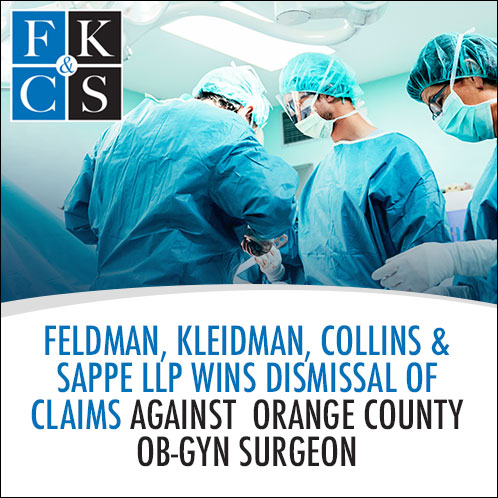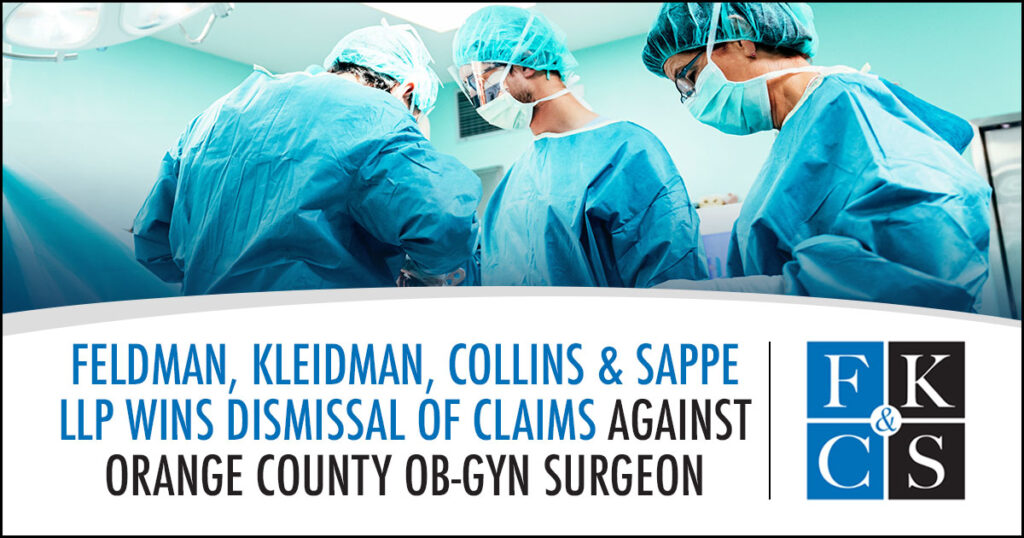 Feldman, Kleidman, Collins & Sappe LLP (FKC&S) recently won a dismissal for an Orange County, NY OB-GYN surgeon in a case involving a 31-year-old patient who presented to FKC&S’s client with a 12-year history of abdominal vaginal bleeding with increasing pelvic pain. Following a workup, FKC&S’s client discussed treatment options with the patient and her husband; they agreed to proceed with a diagnostic/possible operative laparoscopy, removal of the patient’s intrauterine device (IUD) and possible removal of ovarian cysts and endometriotic implants, if present. FKC&S’s client discussed the risks and benefits of – and alternatives to – these procedures, which included possible damage to adjacent organs, including the bowel.
Feldman, Kleidman, Collins & Sappe LLP (FKC&S) recently won a dismissal for an Orange County, NY OB-GYN surgeon in a case involving a 31-year-old patient who presented to FKC&S’s client with a 12-year history of abdominal vaginal bleeding with increasing pelvic pain. Following a workup, FKC&S’s client discussed treatment options with the patient and her husband; they agreed to proceed with a diagnostic/possible operative laparoscopy, removal of the patient’s intrauterine device (IUD) and possible removal of ovarian cysts and endometriotic implants, if present. FKC&S’s client discussed the risks and benefits of – and alternatives to – these procedures, which included possible damage to adjacent organs, including the bowel.
Several weeks later, the surgery was performed as discussed with the patient and her husband. After an overnight stay, the patient was discharged. Four days later, the patient presented to the emergency department (ED) complaining of upper abdominal pain, which led to a diagnosis of a perforated bowel. The perforation was surgically repaired, and a colostomy was placed, which was ultimately reversed nine months later.
The patient and her husband claimed that FKC&S’s client had negligently caused the bowel perforation – even though they acknowledged that it was a known risk of the surgery – and failed to discover and repair it during the laparoscopic surgery. They claimed that the second surgery and colostomy would not have been necessary if the perforation had been identified and repaired during the initial surgery.
FKC&S filed a motion for summary judgment, arguing that a bowel injury is a recognized complication of laparoscopic vaginal surgery, and that there was no direct injury to the bowel during the procedure. Such an injury would have been visualized immediately and would have caused leakage of fecal matter into the operative field, which did not occur. FKC&S’s client’s expert explained that bowel perforation was most likely the result of a delayed thermal injury – a known risk of the procedure – which is not perceivable intraoperatively and does not manifest itself for several days when the tissue breaks down.
In opposition, one of the patient’s experts averred that an electrocautery burn had “possibly” occurred and would have been visible immediately. The patient’s other expert similarly claimed that the injury occurred intraoperatively and would have been visible immediately. The court rejected both opinions because they were not supported by evidence in the record, and were thus “wholly speculative.”
The patient’s experts also claimed that, had the bowel perforation been identified intraoperatively, the colostomy would not have been necessary. The court rejected this claim as well because it, too, was not supported by any evidence, only speculation. The court granted the motion and dismissed all claims against FKC&S’s client.

